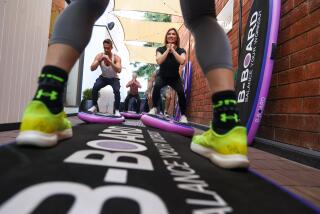A Little SOAP Helps Wash Away the Fears
- Share via
PURCHASE, N.Y. — Six reluctant swimmers, not quite ready for a real pool, sat in a hot tub and clutched rubber duckies. When their instructor suggested putting their faces in the water, they slowly complied.
“Just blow bubbles,” he said. “Good job.”
The students in this case were a man and five women -- average age about 45. Trying to overcome their anxiety around water, they were taking their first class in a course called “SOAP and Water.” SOAP stands for Strategies for Overcoming Aquatic Phobias.
“People can get through life without going in the water, but you miss out on so much,” instructor Jeff Krieger said. But classes like his appear to be rare.
The American Red Cross, with swimming courses nationwide, does not offer classes specifically aimed at adults fearful of the water, although “those people might find what they need in a Level One class,” said Connie Harvey, a Red Cross health and safety expert.
Paul Lennon, who runs the Adult Aquaphobia Swim Center in Glendale and whose techniques include daylong stays in 92-degree water, says he’s seen classes “pop up here and there on the Internet, but it’s a population not well-served.”
Krieger, 49, also teaches children who are afraid of the water -- but it’s the adult classes that have waiting lists.
Krieger says the students tend to be women, many of whom want to enjoy an active retirement or play with their pool-happy grandchildren.
A certified school counselor, Krieger uses trust, group dynamics and a gradual-exposure method. Each hourlong session begins in a classroom with the students in their street clothes. At the first meeting, they’re invited to talk about what brought them to the class.
“I’ve been holding people’s watches for 50 years,” said Cecilia Haas, 54, of Hawthorne. “Everybody else goes in the water and I stay back with the valuables and I’m sick of it. ... I’m not looking to do laps, I just want to lose that panicky feeling that if I get in over my head I’m in trouble.”
Lucy McNair, 51, of Mount Vernon, traced her fear to being knocked over by a breaker as she waded in the Atlantic Ocean. “My girlfriend was with me and the undertow dragged us out and I would have drowned if she hadn’t somehow pulled us up,” McNair said.
Krieger said traumatic incidents -- including parents or instructors using a “sink or swim” approach and purposefully pushing a child’s head under water -- are often the cause of an adult’s fear. But sometimes it’s just an urban upbringing that did not include swimming. And sometimes it’s a mystery.
To help overcome the fear, Krieger encouraged the students to think of some pleasant experience involving water -- a warm bath, for example, or even a beach scene from a movie.
“When we’re in the pool, I want you to find a focal point -- the clock, the diving board, anything -- and when you feel palpitations, look at the focal point and log onto that pleasant memory,” he said.
The students changed into their swimsuits and climbed into the hot tub, where Krieger handed each one a plastic yellow duck as a temporary focal point. After they put their faces in, he said, “What you just did is the only facet of swimming that most people feel uncomfortable about.”
They moved to the pool, with Krieger leading the way to illustrate the 3 1/2-foot depth at the shallow end. He had the students hold their breath for 15 seconds -- above the water. Then he went under for five seconds and said, “That probably seemed like a long time, but it’s only one-third of what you did already. You’re not going to run out of air.”
He asked the students to try going under for two seconds and all but one were willing. Eventually, with the support of her fellow students, the reluctant student joined in.
Judith Chessa, coordinator of the Anxiety and Phobia Treatment Center at White Plains Hospital Center, said exposure in manageable steps is the key to treating phobias.
“If I had a fear of elevators, at my first session I might just be able to stand in front of the elevator and watch people go up and down. My second session, I might be able to put my hand in when the door opens and take it out again. ... You learn to manage your anxiety.”
The Anxiety Disorders Assn. of America does not have figures on the number of people afflicted with aquaphobia but says 4.4% of Americans suffer from specific phobias, including fear of water, fear of dogs and others.
Krieger spent the rest of the session helping the swimmers feel buoyant -- with the help of neon-colored foam “noodles” -- and dispensing confidence.
At the end, he had the group hold hands, take deep breaths and duck under one last time.
“Everybody’s under water,” he said. “This is amazing progress.”


